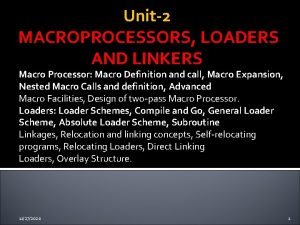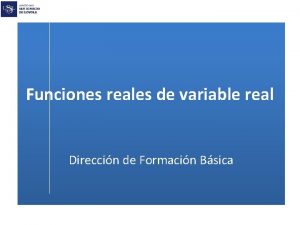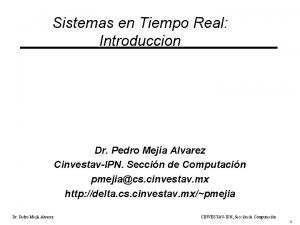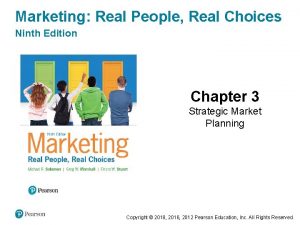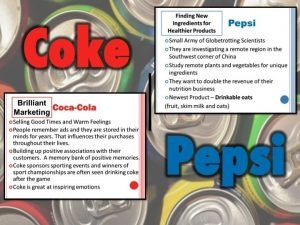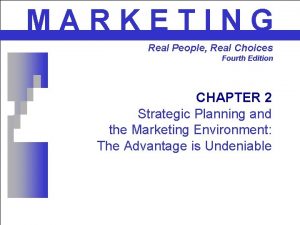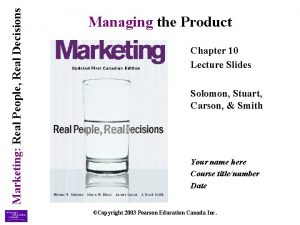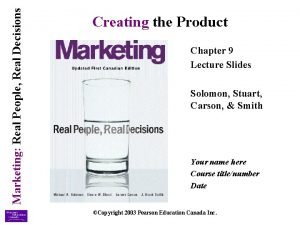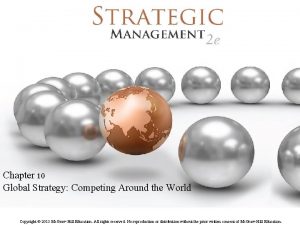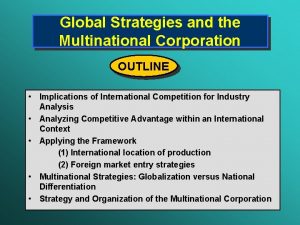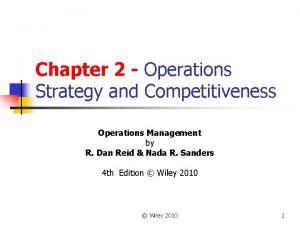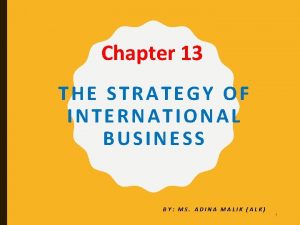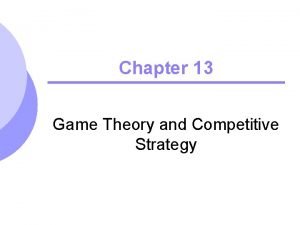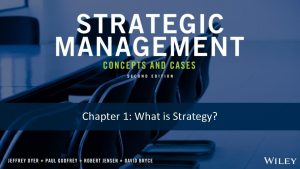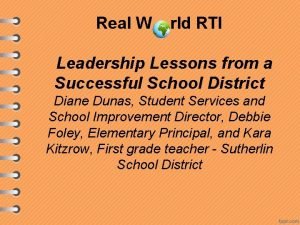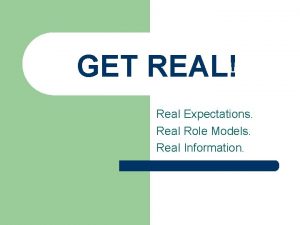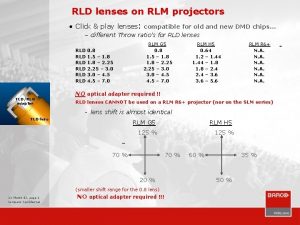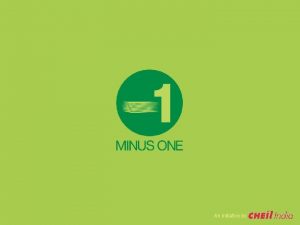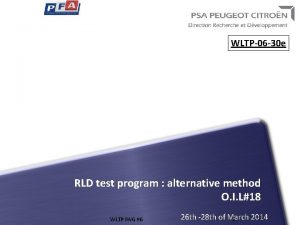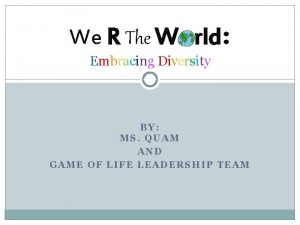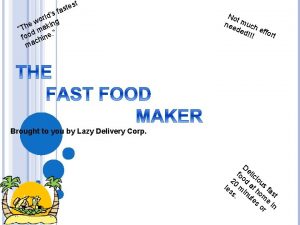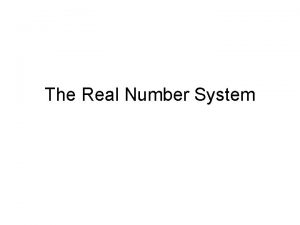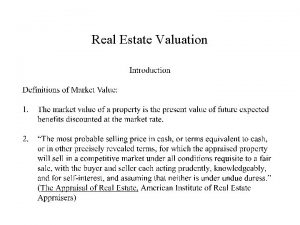Chapter 1 What is Strategy STRATEGY RLD REAL





























- Slides: 29

Chapter 1: What is Strategy?

STRATEGY RLD REAL WO Strategic Management TOOLS CONCEPTS CHAPTER 1: WHAT IS STRATEGY

What is Strategy? A dynamic plan to gain, and sustain, competitive advantage.

STRATEGY: PLAN TO ACHIEVE COMPETITIVE ADVANTAGE Strategy Competitive Advantage Shareholder Value 1. Markets: What markets (industries and geographic markets) the company will pursue in search of a high return on invested capital. 2. Unique Value (why we win with customers): What unique value to offer the customer in those markets (the firm’s value proposition: cost and/or differentiation). 3. Resources and Capabilities (how we deliver unique value): What resources (e. g. , assets, brands, etc. ) and capabilities (e. g. , processes) will allow the firm to deliver a superior value proposition to customers. 4. Barriers to Imitation: How the company will prevent imitation of its strategy by competitors.

4 KEY STRATEGIC QUESTIONS MARKETS UNIQUE VALUE RESOURCES & CAPABILITIES BARRIERS TO IMITATION What markets (industries and geographic) the company will pursue in search of a high return on invested capital. What unique value to offer customers in those markets. The firm’s value proposition: cost or differentiation What resources (assets, brands, etc. ) and capabilities (processes) will allow the firm to deliver a superior value proposition to customers. What will prevent imitation of the company strategy by competitors. Where do we compete? What unique value do we offer to win with customers? How do we deliver unique value? What do we do to block competition? .

STRATEGIC MANAGEMENT PROCESS Ø Strategic Management Process The process by which organizations formulate a plan and allocate resources to achieve competitive advantage that involves making four strategic choices: (1) markets to compete in; (2) unique value the firm will offer in those markets; (3) the resources and capabilities required to offer that unique value better than competitors; and (4) ways to sustain the advantage by preventing imitation. Ø External Analysis Examining the forces that influence industry attractiveness, including opportunities and threats that exist in the environment. Ø Internal Analysis The analysis of a firm’s resources and capabilities to assess how effectively the firm is able to deliver the unique value (value proposition) that it hopes to provide to customers.


WHERE DO YOU COMPETE What geographic markets will you compete in? What industry (broadly defined) will you compete in? What specific “jobs” will you do for what customer segments?

FIRST NATIONAL STORES (FINAST) • First National Stores (stores named Finast) operated supermarkets in the northeast and midwest. • The company operated superstores that were typical grocery stores like Safeway (neither high end or low end). • Finast was considering entering a small city that was growing rapidly. Three stores were in the city—Macy’s (a local chain store) was 50 years old, Acme (also a local chain) was 30 years old, and a Safeway that was 15 years old (names are disguised). All three stores were very profitable. Finast has decided to enter the market because there is enough demand that it can easily accommodate an additional store with all stores staying profitable. Where would you put a new store (or stores) in this city and what would be your strategy for success?

What is Your Market Entry Strategy? Food Retailing City A: High Growth Market 1 Macys 3 Safeway Option 1 Strategic Intent: Avoid Rivalry 2 Acme 4 Finast Unique Value: Convenience; but no sustainable cost or differentiation advantage

What is Your Market Entry Strategy? Food Retailing City A: High Growth Market 1 Macys 3 Safeway 2 Acme 4 Finast Option 2 Strategic Intent: Offer Unique Value Proposition (e. g. , Costco; Trader Joes) Unique Value: Differentiation or low cost; be centrally located

What is Your Market Entry Strategy? Food Retailing City A: High Growth Market 1 Macys 4 Finast 3 Safeway 2 Acme 6 Finast 5 Finast Option 3 Strategic Intent: Eliminate Rival(s) Unique Value: Low cost due to multiple stores; equal convenience; differentiation possible with larger stores

What is Your Market Entry Strategy? Food Retailing City A: High Growth Market 1 Macys 4 Finast 3 Safeway 2 Acme 5 6 Finast Option 4 Strategic Intent: Eliminate one rival; maintain market symmetry Finast 5 Finast Unique Value: Low cost due to multiple stores; differentiate with larger stores offering better selection

FINAST’S STRATEGY IN THIS MARKET Finast Unique Value (Value Proposition) Ø Low Price Finast Unique Value (Value Proposition) Ø Better Selection Ø Lower “local” costs (advertising, training, distribution, etc. ) due to more stores than competitors Ø Just as Convenient Ø Larger stores to offer more variety. Ø Greater brand awareness due to more stores/lower marketing costs

TWO GENERIC STRATEGIES TO OFFER UNIQUE VALUE Ø Cost Advantage An advantage that a firm has over its competitors in the activities associated with producing a product or service, thereby allowing it to produce the same product at lower cost. Ø Differentiation Advantage An advantage a firm has over its competitors by making a product more attractive by offering unique qualities in the form of features, reliability, and convenience that distinguishes it from competing products.

GENERIC STRATEGIES Sources of Advantage ns i arg Industry Average Price M s Cost Low Cost Differentiation

A “VALUE” STRATEGY IN BETWEEN LOW COST VALUE DIFFERENTIATION Efficiency Best Value for the Price Premium Value Providing similar product at a lower price Providing a combination of features and price between low priced and premium value offerings Providing unique product with attributes buyers will pay for

HOW TO DELIVER UNIQUE VALUE: RESOURCES AND CAPABILITIES “The essence of strategy is in the activities – choosing to perform activities differently or to perform different activities than rivals do. ”. - Michael Porter Doing Different Things Competitive Advantage Doing Similar Things Differently

HOW TO BLOCK THE COMPETITION Competitive advantage exists when competitors can’t or won’t imitate A company’s resources and capabilities are key to blocking imitation

WHAT GUIDES STRATEGY FORMULATION? Mission A company’s primary purpose that often specifies the business or businesses in which the firm intends to compete—or the customers it intends to serve. SWOT Analysis Strategic planning method used to evaluate the strengths, weaknesses, opportunities, and threats involved in a business. • External analysis involves: (1) an examination of the competition and the forces that shape industry competition and profitability; and (2) customer analysis to understand what customers really want. • Internal Analysis involves an analysis of the company’s set of resources and capabilities that can be deployed—or should be developed—to deliver unique value to customers.

DELTA MARKETING STRATEGY In the mid 1980 s Delta’s market researchers found that customers (particularly business customers) were strongly influenced to choose a particular airline by the airline’s frequent flyer program. Consequently, to motivate customers to choose Delta, they teamed up with American Express (an exclusive arrangement) to offer a special program: customers receive triple miles if they fly on Delta and purchase the tickets using the American Express card. How would you evaluate Delta’s strategy? Good or Bad?

WHAT HAPPENED? Ø All major competitors quickly decided to offer triple miles with every flight—regardless of how the customer paid. Ø Customers that wanted to pay with Visa or another credit card—or cash—were more likely to fly another airline. Ø Delta’s action raised the costs of all airlines without giving any of them an advantage—the customer was the only one better off. Ø This action did not produce any sustainable advantage for Delta.

BARRIERS TO IMITATION Ø What is the cost of the strategic initiative? Ø How long will it take for competitors to imitate the strategic initiative? Ø Is there a Barrier to Imitation? If competitors can quickly and easily imitate, then it raises all rival’s costs without creating advantage.

HOW ARE STRATEGIES FORMULATED? Corporate Strategy Decisions about what markets to compete in, made by executives at the corporate level of an organization. Business Unit Strategy Decisions about how to gain and sustain advantage, made at the manager level for each standalone business unit within a company. Functional Strategy Decisions about how to effectively implement the business unit strategy within functional areas like finance, product development, operations, information technology, sales and marketing, and customer service. Strategy Vehicles Activities and strategic choices—such as make versus buy, acquisitions, and strategic alliances—that influence a firm’s ability to enter particular markets, deliver unique value to customers, or create barriers to imitating its product.

MULTIPLE LEVELS OF STRATEGIC ANALYSIS Corporate Strategy Business Unit 1 Strategy R&D Strategy Business Unit 2 Strategy Operations/ Manufact. Strategy Sales/ Marketing Strategy Identifies where to compete in terms of industries and markets. Identifies what unique value to offer (cost or differentiation) and how to deliver it Human Resource Strategy Strategies and tactics of the functional units should align with and implement the overall business unit strategy. Provides guidance for managing and allocating resources to distinct business units. Provides a plan to achieve competitive advantage

STRATEGY IMPLEMENTATION Strategy Implementation The translation of a chosen strategy into organizational action so as to effectively implement the activities required to achieve strategic goals and objectives. Effective implementation typically requires the following: 1. The functional strategies within the company—research and development, operations, sales and marketing, human resource management—are well aligned with delivering the unique value identified in the overall strategy. Implementation is generally more successful when a company can measure how effectively functional activities are being performed to support the overall strategy. 2. The organization’s structure, systems, staff , skills, style (culture), and shared values are designed to facilitate the execution of the strategy.

WHO IS RESPONSIBLE FOR BUSINESS STRATEGY? Strategic Leaders Organizational leaders charged with formulating and implementing a strategy with the objective of ensuring the survival and success of an organization. • Deliberate Strategy: A plan or pattern of action that is formulated through a deliberate planning process that is then carried out to achieve the mission or goals of an organization. • Emergent Strategy: A plan or pattern of action that develops and emerges over time in an organization despite a mission or goals.

STRATEGY RLD REAL WO Strategic Management TOOLS CONCEPTS CHAPTER 1: WHAT IS STRATEGY?

Appendix SLIDE 2 & 28: Images Provided by Presenter. Media. com
 Subroutine linkage loader
Subroutine linkage loader Funciones reales de una variable real
Funciones reales de una variable real The real real fashion copywriter
The real real fashion copywriter Sensor and (tiempo real or real time)
Sensor and (tiempo real or real time) Polynomial function in real life
Polynomial function in real life Ch 9 ream people real choice case study
Ch 9 ream people real choice case study The real thing short story
The real thing short story Marketing real people real choices
Marketing real people real choices Real homes real estate
Real homes real estate Marketing real people real choices 11th edition
Marketing real people real choices 11th edition Marketing real people real decisions
Marketing real people real decisions Marketers classify innovations based on their
Marketers classify innovations based on their Real time strategy game
Real time strategy game Corporate strategy and business strategy
Corporate strategy and business strategy Multi domestic strategy
Multi domestic strategy Chase production strategy example
Chase production strategy example Transnational strategy
Transnational strategy Aligning hr strategy with business strategy
Aligning hr strategy with business strategy Porter’s diamond of national advantage
Porter’s diamond of national advantage Process of crafting and executing strategy
Process of crafting and executing strategy Strategy formation
Strategy formation What is listening strategies
What is listening strategies Directional strategies in strategic management
Directional strategies in strategic management International or multinational
International or multinational Chapter 11 real estate and other investments
Chapter 11 real estate and other investments Chapter 2 operations strategy and competitiveness
Chapter 2 operations strategy and competitiveness Operations management chapter 2
Operations management chapter 2 Chapter 13 the strategy of international business
Chapter 13 the strategy of international business Chapter 13 game theory and competitive strategy
Chapter 13 game theory and competitive strategy Chapter 12 planning your tax strategy
Chapter 12 planning your tax strategy
